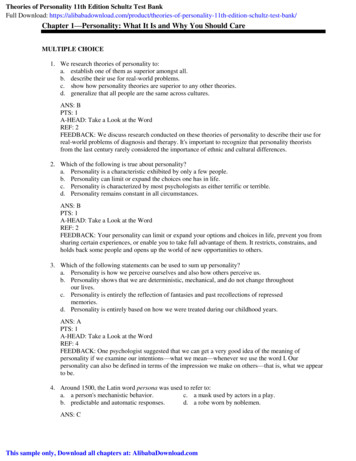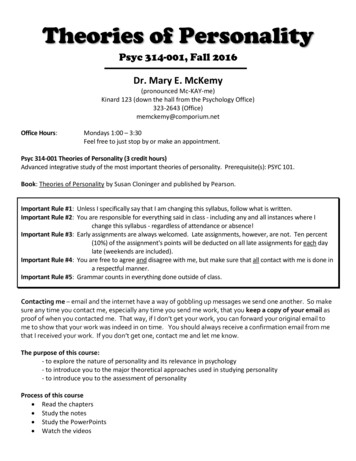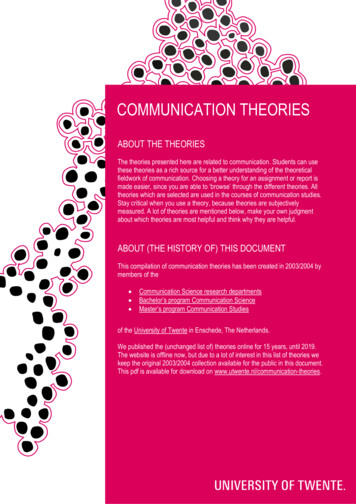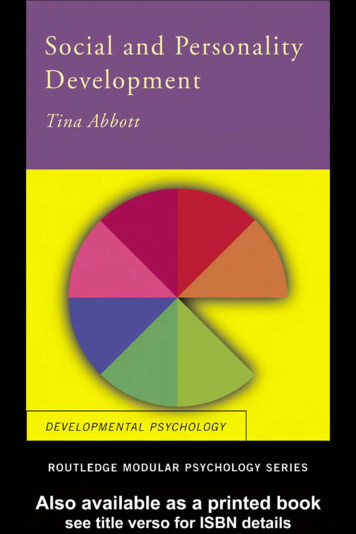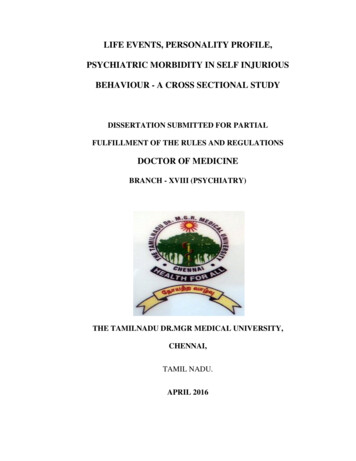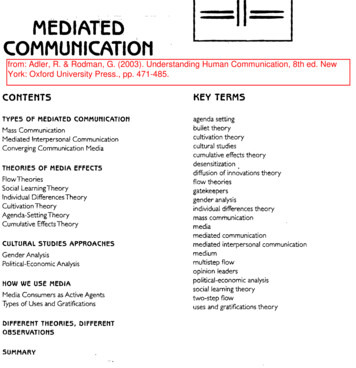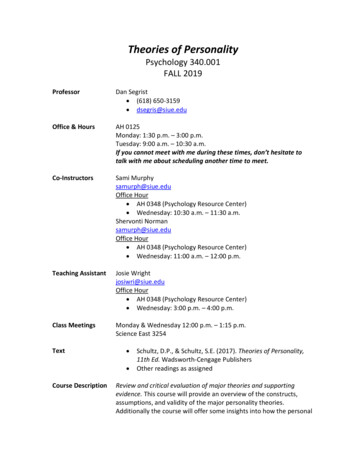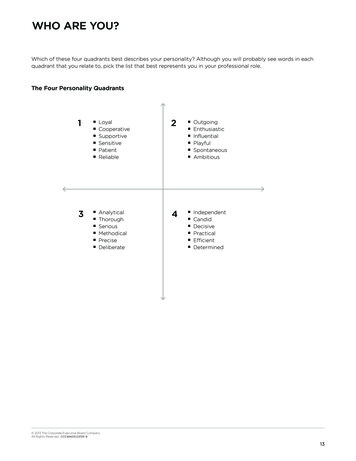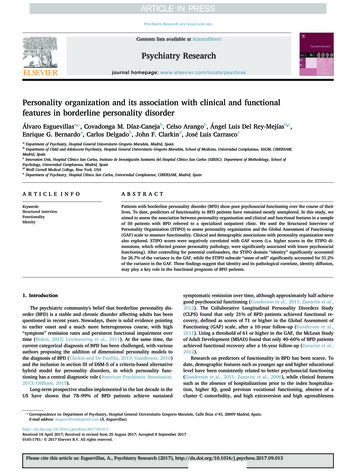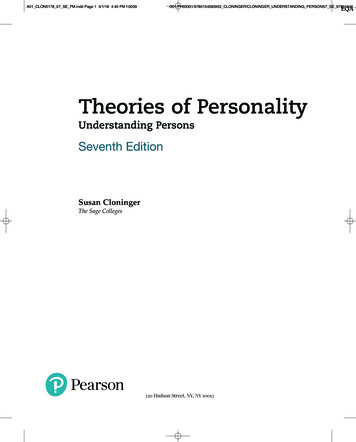
Transcription
A01 CLON5178 07 SE FM.indd Page 1 3/1/18 4:40 PM f-0039/201/PH03331/9780134583952 CLONINGER/CLONINGER UNDERSTANDING PERSONS7 SE 97801345 .Theories of PersonalityUnderstanding PersonsSeventh EditionSusan CloningerThe Sage Colleges330 Hudson Street, NY, NY 10013
A01 CLON5178 07 SE FM.indd Page 2 3/5/18 4:34 PM f-0039/201/PH03331/9780134583952 CLONINGER/CLONINGER UNDERSTANDING PERSONS7 SE 97801345 .Portfolio Manager: Tanimaa MehraPortfolio Manager Assistant: Anna AustinProduct Marketer: Jessica QuazzaContent Developer: Elisa RogersContent Development Manager: Gabrielle WhiteArt/Designer: iEnergizer/Aptara , Ltd.Digital Studio Course Producer: Lindsay VergeFull-Service Project Manager: iEnergizer/Aptara , Ltd.Compositor: iEnergizer/Aptara , Ltd.Printer/Binder: LSC, KendallvilleCover Printer: PhoenixCover Design: Lumina DatamaticsCover Art: Pentagram/Noma BarAcknowledgements of third party content appear on page 399, which constitutes an extension of this copyrightpage.Copyright 2019, 2013, 2008 by Pearson Education, Inc. or its affiliates. All Rights Reserved. Printed in theUnited States of America. This publication is protected by copyright, and permission should be obtained fromthe publisher prior to any prohibited reproduction, storage in a retrieval system, or transmission in any form orby any means, electronic, mechanical, photocopying, recording, or otherwise. For information regardingpermissions, request forms and the appropriate contacts within the Pearson Education Global Rights &Permissions department, please visit www.pearsoned.com/permissions/.PEARSON, ALWAYS LEARNING, and REVEL are exclusive trademarks owned by Pearson Education, Inc. orits affiliates, in the U.S., and/or other countries.Unless otherwise indicated herein, any third-party trademarks that may appear in this work are the property oftheir respective owners and any references to third-party trademarks, logos or other trade dress are for demonstrative or descriptive purposes only. Such references are not intended to imply any sponsorship, endorsement,authorization, or promotion of Pearson’s products by the owners of such marks, or any relationship between theowner and Pearson Education, Inc. or its affiliates, authors, licensees or distributors.Library of Congress Cataloging-in-Publication DataNames: Cloninger, Susan C., 1945- author.Title: Theories of personality : understanding persons / Susan Cloninger, TheSage Colleges.Description: Seventh edition. Boston : Pearson, [2018] Includesbibliographical references and index.Identifiers: LCCN 2018006466 ISBN 9780134583952 (pbk.)Subjects: LCSH: Personality.Classification: LCC BF698 .C543 2018 DDC 155.2–dc23 LC record available athttps://lccn.loc.gov/2018006466Access Code CardISBN-10:0-134-58395-7ISBN-13: 903-2ISBN-13: 978-0-134-89903-9Books a la CarteISBN-10:0-134-58517-8ISBN-13: 978-0-134-58517-8Instructor’s Review CopyISBN-10:0-134-58512-7ISBN-13: 978-0-134-58512-3
A01 CLON5178 07 SE FM.indd Page 3 3/1/18 4:40 PM f-0039/201/PH03331/9780134583952 CLONINGER/CLONINGER UNDERSTANDING PERSONS7 SE 97801345 .Brief Contents1Introduction to Personality Theory 110Behavioral Theories 1772Freud’s Classical Psychoanalysis11Kelly’s Personal Construct Theory3Jung’s Analytical Psychology124Adler’s Individual PsychologyMischel’s Traits in Cognitive SocialLearning Theory 2165Erikson’s Psychosocial Development 7713Bandura’s Theory on Performance inCognitive Social Learning 2326Horney, Relational Theory, andthe Interpersonal PsychoanalyticApproach 9914Rogers’s Person-Centered Theory15Maslow’s Need Hierarchy Theory andPositive Psychology 26516Buddhist Psychology 28517Concluding Remarks 3051740607Allport’s Personological TraitTheory 1208Two Factor Analytic Trait Theories9Biological Theories137201249156iii
A01 CLON5178 07 SE FM.indd Page 4 3/1/18 4:40 PM f-0039/201/PH03331/9780134583952 CLONINGER/CLONINGER UNDERSTANDING PERSONS7 SE 97801345 .ContentsPreface1ixIntroduction to Personality Theory2.4.511.1Personality1.1.1 Definition of Personality221.2Description of Personality1.2.1 Differences Between People331.3Personality Dynamics1.3.1 Adaptation and Adjustment1.3.2 Cognitive Processes1.3.3 Culture44441.4Personality Development51.5The Scientific Approach1.5.1 Theory1.5.2 Criteria of a Good Theory1.5.3 Eclecticism and the Future of PersonalityTheory1.5.4 Relationship Between Theory andResearch6771.6Methods in Personality Research1.6.1 Personality Measurement1.6.2 Correlational Studies1.6.3 Experimentation1.6.4 Studying Individuals: Case Studies andPsychobiographySummary: Introduction to Personality Theory22.12.22.32.4ivEmpirical Studies of Defenses302.5Personality Development2.5.1 The Five Psychosexual Stages31322.6Psychoanalysis2.6.1 The Process of Psychoanalytic Therapy2.6.2 The Recovered Memory Controversy2.6.3 Psychoanalysis as a Scientific Theory2.6.4 Silverman’s Experiments2.6.5 Nonconscious Cognition2.6.6 Nonconscious Influences and the Brain34343536363638Summary: Freud’s Classical Psychoanalysis3Overview of Jung’s Theory3.1.1 Biography of Carl Jung3.1.2 Evaluating Jung’s Theory4343443.2The Structure of Personality3.2.1 The Psyche and the Self: The Personalityas a Whole3.2.2 Ego3.2.3 Persona3.2.4 Shadow3.2.5 Anima and Animus45101013141515Freud’s Classical Psychoanalysis17Overview of Freud’s Theory2.1.1 Biography of Sigmund Freud2.1.2 Freud’s Theory in His Time, and Ours2.1.3 Evaluating Freud’s Theory20202121The Unconscious2.2.1 Psychic Determinism2.2.2 Levels of Consciousness2.2.3 Effects of Unconscious Motivation2.2.4 Origin and Nature of the Unconscious2121222225Structures of the Personality2.3.1 The Id2.3.2 The Ego2.3.3 The Superego25262727Intrapsychic Conflict2.4.1 Energy Hypothesis2.4.2 Anxiety2.4.3 Defense Mechanisms2.4.4 Sublimation and Creativity2828282930403.199Jung’s Analytical Psychology383.34546464646Collective Unconscious3.3.1 The Shadow and the Anima or Animus asArchetypes3.3.2 Other Archetypes3.3.3 Psychosis: Dangers of the CollectiveUnconscious3.3.4 Symbolism and the Collective Unconscious49493.4Therapy3.4.1 Dreams3.4.2 Other Symbolic Therapy Techniques5152523.5Synchronicity533.6Psychological Types3.6.1 Introversion and Extraversion3.6.2 The Four Functions3.6.3 Measurement and Application54545556Summary: Jung’s Analytical Psychology44.1Adler’s Individual PsychologyOverview of Adler’s Theory4.1.1 Biography of Alfred Adler4.1.2 Interventions Based on Adler’s Theory4748485860636465
A01 CLON5178 07 SE FM.indd Page 5 3/1/18 4:40 PM f-0039/201/PH03331/9780134583952 CLONINGER/CLONINGER UNDERSTANDING PERSONS7 SE 97801345 .Contents4.2Striving From Inferiority Toward Superiority4.2.1 Inferiority4.2.2 Adler’s Evolving Ideas About Striving toImprove4.2.3 Fictional Finalism67684.3The Unity of Personality4.3.1 Style of Life4.3.2 Mistaken and Healthy Styles of Life6969704.4The Development of Personality4.4.1 Parental Behavior4.4.2 Family Constellation717171Psychological Health4.5.1 The Three Tasks of Life7474Summary: Adler’s Individual Psychology764.556767Erikson’s Psychosocial Development 775.1Overview of Erikson’s Theory5.1.1 Biography of Erik Erikson5.1.2 The Epigenetic Principle8080825.2The Psychosocial Stages5.2.1 Lifespan Ego Development in a SocialContext5.2.2 The Psychosocial Stages Described838484The Role of Culture in Relation to thePsychosocial Stages875.4Sexual, Racial, and Ethnic Identity5.4.1 Gender Identity and Sexual Orientation5.4.2 Racial/Ethnic Identity9090915.5Research on Psychosocial Development5.5.1 Identity Status5.5.2 Research on Other Psychosocial Stages5.5.3 Correlates of Stage Measures5.5.4 Applications to Psychoanalysis andPsychoanalytic Social Psychology939394955.3Summary: Erikson’s Psychosocial Development66.16.2Horney, Relational Theory,and the InterpersonalPsychoanalytic ApproachOverview of Interpersonal PsychoanalyticTheory6.1.1 The Life of Karen Horney6.1.2 Interpersonal Psychoanalysis: Horney6.1.3 Horney’s Approach to TherapyThree Interpersonal Orientations6.2.1 Moving Toward People: The Self-EffacingSolution6.2.2 Moving Against People: The ExpansiveSolution6.2.3 Moving Away from People: TheResignation Solution6.2.4Adjustments to Basic Anxiety6.3.1 Four Major Adjustments to Basic Anxiety6.3.2 Secondary Adjustment Techniques1071071086.4Personality Development6.4.1 Gender Roles6.4.2 Cross-Cultural Differences6.4.3 Parental Behavior and PersonalityDevelopment1091091106.5The Relational Approach Within PsychoanalyticTheory6.5.1 Object Relations6.5.2 The Sense of Self in Relationships6.5.3 Narcissism6.5.4 The Relational Approach to Therapy112113113114115Attachment in Infancy and Adulthood6.6.1 Infant Attachment6.6.2 Adult Attachments and Relationships6.6.3 Longitudinal Studies of Attachment1161161161186.6Summary: Horney, Relational Theory, and theInterpersonal Psychoanalytic Approach7105106106107111118Allport’s Personological Trait Theory 1207.1Overview of Allport’s Theory7.1.1 Biography of Gordon Allport7.1.2 Major Themes in Allport’s Work7.1.3 Eclecticism1231231241257.2Allport’s Definition of Personality7.2.1 Dynamic Organization7.2.2 Psychophysical Systems7.2.3 Determinative7.2.4 Unique7.2.5 Adjustments to the Environment1251251251251261267.3Personality Traits7.3.1 Allport’s Definition of Trait7.3.2 Can We All Be Described by the SameTraits?7.3.3 Inferring Traits7.3.4 The Pervasiveness of Traits7.3.5 Levels of Integration of Personality1261261261271291297.4Personality Development7.4.1 Functional Autonomy7.4.2 Qualities of a Normal, Mature Adult7.4.3 Unity of Personality7.4.4 Stages of Development1291291301301317.5Personality and Social Phenomena7.5.1 Religious Orientation7.5.2 Prejudice7.5.3 Religion and Prejudice7.5.4 Rumor 7Healthy Versus Neurotic Use ofInterpersonal OrientationsvSummary: Allport’s Personological Trait Theory136
A01 CLON5178 07 SE FM.indd Page 6 3/1/18 4:40 PM f-0039/201/PH03331/9780134583952 CLONINGER/CLONINGER UNDERSTANDING PERSONS7 SE 97801345 .vi Contents88.18.28.38.4Two Factor Analytic Trait Theories137Overview of Factor Analytic Trait Theories8.1.1 Factor Analysis8.1.2 The 16 Factor Theory: Cattell8.1.3 Biography of Raymond Cattell8.1.4 The Role of Theory in Cattell’s EmpiricalApproach140142142142Personality Measurement and the Prediction ofBehavior8.2.1 Because Personality Is Complex:A Multivariate Approach8.2.2 Psychological Adjustment8.2.3 Three Types of Traits8.2.4 Predicting Behavior8.2.5 Determinants of Personality: Heredityand Environment147The Five-Factor Model (FFM)8.3.1 The Big Five Personality Traits8.3.2 A Hierarchical Model148148151Are the Five Factors Universal?8.4.1 Various Measures of the Big Five8.4.2 Factors and Other PersonalityConstructs152152Summary: Two Factor Analytic Trait Theories9143Biological Theories1431441441451471521541569.1Overview of Biological Theories9.1.1 Biological Approach9.1.2 Biological Mechanisms in Context1591591599.2Evolutionary Approaches9.2.1 Evolutionary Paradigm for PersonalityTheory9.2.2 Aggression and Dominance9.2.3 Sexual Behavior9.2.4 Parental Behavior9.2.5 Altruism and Social Emotions9.2.6 Culture161161162162164164165Biological Influences on Personality9.3.1 Genetics9.3.2 Temperament9.3.3 Emotional Arousal9.3.4 Cortical Arousal1651651671691699.39.4Biological Factor Theories: Eysenck, Gray,and Others9.4.1 Eysenck’s “PEN” Biological Model9.4.2 Gray’s Reinforcement SensitivityTheory9.4.3 Cloninger’s Tridimensional ModelSummary: Biological Theories10Behavioral Theories10.1 Overview of Behavioral Theories10.1.1 Major Behavioral Theories10.1.2 The Act Frequency Approach toPersonality Measurement10.1.3 Contributions of Behaviorism toPersonality Theory18310.2 Behavior Theorists10.2.1 Biography of B. F. Skinner10.2.2 Biography of John Dollard10.2.3 Biography of Neal Miller10.2.4 Biography of Arthur Staats18318318418418510.3 Radical Behaviorism: Skinner10.3.1 Behavior as the Data for ScientificStudy10.3.2 Learning Principles10.3.3 Applications of Behavioral Techniques10.3.4 Radical Behaviorism and Personality:Some Concerns18610.4 Psychoanalytic Learning Theory: Dollardand Miller10.4.1 Learning Theory Reconceptualizationof Psychoanalytic Concepts10.4.2 Four Fundamental Concepts aboutLearning10.5 The Learning Process10.5.1 Learning by Imitation10.5.2 The Four Critical Training Periodsof Childhood10.5.3 Frustration and Aggression10.5.4 Conflict10.5.5 Language, Neurosis, and Psychotherapy10.5.6 19119119219310.6 Psychological Behaviorism: Staats10.6.1 Reinforcement10.6.2 Situations10.6.3 Basic Behavioral Repertoires10.6.4 The Emotional-Motivational Repertoire10.6.5 The Language-Cognitive Repertoire10.6.6 The Sensory-Motor Repertoire10.6.7 Psychological Adjustment10.6.8 The Nature-Nurture Question fromthe Perspective of PsychologicalBehaviorism197Summary: Behavioral Theories1991711711117317411.1 Overview of Kelly’s Theory11.1.1 Biography of George Kelly11.1.2 Constructive Alternativism11.1.3 The Process of Construing175177Kelly’s Personal Construct Theory193193194194195195197197201203204205205
A01 CLON5178 07 SE FM.indd Page 7 3/5/18 4:36 PM f-0039/201/PH03331/9780134583952 CLONINGER/CLONINGER UNDERSTANDING PERSONS7 SE 97801345 .Contents11.1.4 The Structure of Construct Systems11.1.5 The Social Embeddedness of ConstruingEfforts20611.2 Cognitive Complexity11.2.1 The Role Construct Repertory (REP) Test11.2.2 Personality Change11.2.3 Therapy20920921121211.3 Research Applications11.3.1 Therapy Applications11.3.2 Business Applications11.3.3 Other Applications213213214214Summary: Kelly’s Personal Construct Theory21412Mischel’s Traits in CognitiveSocial Learning Theory20621612.1 Overview of Mischel’s Theory12.1.1 Implications of Mischel’s Theory12.1.2 Biography of Walter Mischel21921921912.2 Delay of Gratification22012.3 Personality Traits: Mischel’s Challenge12.3.1 The Consistency Paradox12.3.2 The Situational Context of Behavior12.3.3 The Wediko Camp Study12.3.4 Learned Patterns of Situation–BehaviorRelationships12.3.5 The Consistency Question as aContinuing Theoretical Challenge22222222322322322512.4 The CAPS Model12.4.1 Encoding Strategies and PersonalConstructs12.4.2 Expectancies12.4.3 Affects12.4.4 Goals and Values12.4.5 Competencies and Self-Regulatory Plans12.4.6 Applications of the CAPS Modelof Personality228Summary: Mischel’s Traits in Cognitive SocialLearning Theory23113Bandura’s Theory on Performancein Cognitive Social Learningvii13.3 Therapy13.3.1 Social Learning Therapy13.3.2 Self-Efficacy and Therapy245246246Summary: Bandura’s Theory on Performancein Cognitive Social Learning24814Rogers’s Person-Centered Theory24914.1 Overview of Rogers’s Theory14.1.1 Biography of Carl Rogers14.1.2 Criticisms of Rogers’s Theory25125325414.2 The Actualizing Tendency14.2.1 The Organismic Valuing Process14.2.2 The Fully Functioning Person14.2.3 Subjective Experience and Science25525525525614.3 The Self14.3.1 Development14.3.2 Development of Creativity25625725714.4 Therapy14.4.1 Client-Centered Therapy14.4.2 Research on Therapy14.4.3 Encounter Groups25725825926114.5 Other Applications14.5.1 Humanistic Education14.5.2 Marriage and Relationships14.5.3 Business14.5.4 Political Conflict, War, and Peace261261262262262Summary: Rogers’s Person-Centered Theory26322622622722722822823213.1 Overview of Bandura’s Theory13.1.1 Biography of Albert Bandura13.1.2 Reciprocal Determinism13.1.3 Self-Regulation of Behavior13.1.4 Self-Efficacy13.1.5 The Person in the Social Environment23523623623723724113.2 Processes Influencing Learning13.2.1 Observational Learning and Modeling24224315Maslow’s Need Hierarchy Theoryand Positive Psychology15.1 Overview of Maslow’s Theory and PositivePsychology15.1.1 Biography of Abraham Maslow15.1.2 Need Hierarchy Theory: Maslow15.1.3 Maslow’s Vision of Psychology15.1.4 Maslow’s Challenge to Traditional Science15.1.5 The Promise of Positive Psychology26526826826926927027015.2 Hierarchy of Needs15.2.1 Deficiency Motivation15.2.2 Being Motivation15.2.3 Differences Between D-Motivation andB-Motivation15.2.4 Self-Actualization27027127127227315.3 Applications and Implications of Maslow’sTheory15.3.1 Therapy15.3.2 Workplace15.3.3 Religion and Spirituality15.3.4 Education276276276277277
A01 CLON5178 07 SE FM.indd Page 8 3/5/18 4:37 PM f-0039/201/PH03331/9780134583952 CLONINGER/CLONINGER UNDERSTANDING PERSONS7 SE 97801345 .viii Contents15.4 Positive Psychology15.4.1 Positive Subjective Experience15.4.2 Positive Traits15.4.3 Positive Institutions277278280282Summary: Maslow’s Need HierarchyTheory and Positive Psychology28316Buddhist Psychology16.1 Overview of Buddhist Theory16.1.1 A Brief History of Buddhism16.1.2 Biography of Siddhartha Gautama16.1.3 The Relevance of Buddhism forPersonality Psychology16.1.4 The Dialogue Between Buddhism andScientific Psychology28528828928929029016.2 The Buddhist Worldview: The Four NobleTruths16.2.1 The First Noble Truth: There Is Suffering16.2.2 The Second Noble Truth: The Origin ofSuffering16.2.3 The Third Noble Truth: The Endof Suffering16.2.4 The Fourth Noble Truth: The EightfoldPath29116.3 Buddhism and Personality Concepts16.3.1 Self or Ego16.3.2 Transience and Mortality16.3.3 Behavior: Its Causes and Consequences16.3.4 Mind and Body16.3.5 Emotions16.3.6 Interpersonal Relationships and Society29229229329329429529629029129129116.4 Spiritual Practices16.4.1 Meditation16.4.2 The 17 Moments of Perception16.4.3 Buddhism and Psychotherapy296297299302Summary: Buddhist Psychology30317Concluding Remarks30517.1 Choosing or Combining Theories17.1.1 Eclecicism17.1.2 Pluralism17.1.3 Unified Theory30630630630617.2 Theories as Metaphors17.2.1 The Mechanistic Metaphor17.2.2 The Organic Metaphor17.2.3 The Information-ProcessingMetaphor17.2.4 The Narrative Metaphor17.2.5 The Metaphor of the Emergent Self17.2.6 The Metaphor of the TranscendentSelf17.2.7 The Metaphor of Chaos andComplexity307307307308Summary: Concluding Remarks310Glossary 311References 321Credits399Name Index 406Subject Index430307307308308
A01 CLON5178 07 SE FM.indd Page 9 3/1/18 4:40 PM f-0039/201/PH03331/9780134583952 CLONINGER/CLONINGER UNDERSTANDING PERSONS7 SE 97801345 .PrefaceI’ve been writing and revising this text with its various editions for over a quarter of a century and have come to realize that it will always be a work in process. What used tofeel like “completion” now feels simply like a “milestone”as each new edition is sent to production. That is fitting, asthe field of personality psychology, too, continues todevelop. Over the years, some of the hot topics (like thedebate over traits versus situationalism, and the controversy over repressed memory of abuse) have faded into thehistorical past as theories have matured and research hasguided reconceptualizations, and some topics have beendropped altogether, in order to make room for the new.While not reflected in the words I have crafted for thisedition, I sometimes reminisce about the first term paper Iwrote in my first personality course, where I explored allthat I could find written by Gordon Allport. If there is aunitary vision, however vague and incomplete, for thefield, it seems—at least so far in the development of personality theory—to be his personology. But details arelacking in his statements, and for that, we need many othertheories, ranging from the exciting findings of neuroscience to the very practical and socially important recognition of cultural contexts (e.g., challenges to the Protestantbias of Allport-inspired work on religious orientations). Ido hope that personality researchers and theorists will continue their efforts to reach outside of their theoretical silos,to show how important ideas transcend theoretical boundaries. A unified theory of personality seems a distant goal,however, and one that will need to include other disciplines as well.Researchers and theorists in personality have morecontributions that deserve reporting than I can possiblyinclude in this text: so many research findings and theoretical ideas, it would take a whole series! I invite students todo as I have done, and make understanding personality alife’s work, whether through academic study or by thoughtful observations of self and others. Understanding personsbrings practical as well as academic benefits to our lives.New to This Edition New Illustrative Biographies: Malala Yousafzai(Chapter 4), Serena Williams (Chapter 9), and GeorgeHarrison (Chapter 15). Updated research literature throughout. This includesneuroscience research, not only in the biological chapter but also integrated with various other theories(including Freud, Jung, and meditation in Buddhism). Updated discussion of current thinking and researchabout various theoretical concepts, including archetypesin Jung’s theory (Chapter 3); the replacement child andbullying in Adler’s theory (Chapter 4); epigenetics, gender identity, and sexual orientation in Erikson’s theory(Chapter 5); Alice Miller’s work on childhood victimization (Chapter 6); the effects of both nature and nurture inthe Five-Factor Model (Chapter 8); increased attention toculture and the environment in evolutionary approaches(Chapter 9); and additional research using cultural andhistorical material in Kelly’s theory (Chapter 11). Updated details about various theorists’ lives, including controversy over racism in Cattell’s theory(Chapter 8) and Jung’s theory (Chapter 3); the contributions of his daughter Natalie and his relationship withGloria in the film by Carl Rogers (Chapter 14); and theabusive behavior of Maslow’s mother (Chapter 15). Updated details about some illustrative biographiesthat are continued from the previous edition, including Mother Teresa (Chapter 7), Sonia Sotomayor(Chapter 8), Barack Obama (Chapter 13), and the DalaiLama (Chapter 16). Encouragement of students’ critical thinking aboutmany issues, such as conflict (Chapter 2), synchronicity (Chapter 3), cultural change (Chapter 6), religionand values (Chapter 7), free will (Chapter 10), and selfbeliefs (Chapter 12).Revel Educational technology designed for the way today’s students read, think, and learnWhen students are engaged deeply, they learn moreeffectively and perform better in their courses. This simplefact inspired the creation of Revel: an immersive learningexperience designed for the way today’s students read,think, and learn. Built in collaboration with educators andstudents nationwide, Revel is the newest, fully digital wayto deliver respected Pearson content.Revel enlivens course content with media interactivesand assessments—integrated directly within the authors’narrative—that provide opportunities for students to readabout and practice course material in tandem. This immersive educational technology boosts student engagement,which leads to better understanding of concepts andimproved performance throughout the course.Learn more about Revel - https://www.pearson.com/revelix
A01 CLON5178 07 SE FM.indd Page 10 3/1/18 4:40 PM f-0039/201/PH03331/9780134583952 CLONINGER/CLONINGER UNDERSTANDING PERSONS7 SE 97801345 .x PrefaceAvailable InstructorResourcesThe following resources are available for instructors. Thesecan be downloaded at https://www.pearsonhighered.com.Login required.PowerPoint—provides a core template of the contentcovered throughout the text. These can easily be addedto customize for your classroom.Instructor’s Manual—includes key terms, lectureideas, teaching tips, suggested readings, chapter outlines and student assignments.Test Bank—includes multiple-choice, true/false, andessay questions. They are tied to the numbered learning objectives from the text and tagged as per the levelof difficulty and skill type.MyTest—an electronic format of the Test Bank to customize in-class tests or quizzes.About The AuthorSusan C. Cloninger, PhD, is a professor emerita from TheSage Colleges, Troy and Albany, New York, where shetaught psychology for 36 years. Her graduate study was atthe University of Michigan in Ann Arbor, where she earneda PhD in psychology with specialization in personality (inparticular, social motivation). In addition to Theories of Personality: Understanding Persons, she has contributed to theCambridge Handbook of Personality Psychology. In retirement,Sue is active as a volunteer in a supportive housing unit forpersons with a history of homelessness and mental illness;in her Unitarian Universalist church; and as an amateurgardener and proud grandmother. Her professional curiosity is a quest for understanding that bridges issues frombiological to social-political understanding.AcknowledgmentsWith each revision, it becomes increasingly apparent thatbooks require a team effort, even when only one author islisted. This seventh edition is no exception. Indeed, overthe decades that I have been learning to become an author,I’ve come to rely on others as helpers, rather than fearingtheir judgments.First, thanks to Pearson. They envisioned the firstRevel edition and guided me through the translation of myideas into a new format, with enhanced pedagogy builtinto the text. I’ve done a lot of online teaching, both at TheSage Colleges and Empire State College, but never with theintegration of activities with content that this excitingformat permits. I know that the management skills ofsponsoring editor Bimbabati Sen and development editorElisa Rogers have made my work much easier.In particular, I am much indebted to Elisa Rogers, mydevelopment editor, who has worked closely with methroughout the revision process, interpreting the overallRevel vision and formatting to me in ways that this novicecould understand, and gently suggesting better ways toimplement my ideas. Her professional expertise and herpersonable presence has made me look forward to heremails. Certainly the book is much improved by Elisa’sgentle hand, and the process was much more enjoyable.I’ve occasionally bounced ideas off friends and colleagues that helped shape the decisions for the new edition, including my choice of biographies to illustrate thevarious theories. Particular thanks to Syb, Christy, Tony,and people I’ve come to know at the Hill Street Inn. Thisedition includes some of those suggestions, and I welcomeadvice for future editions (email: clonis@sage.edu). I’mreluctant, though, to analyze living people, especially thosewho, because of youth or changing circumstances, are stilldeveloping or revealing their personalities—though I’vemade an exception in the case of Malala Yousafzai.My family, John and Krissy in particular, have encouraged me and helped keep writing in perspective, and mygrandson Ollie has me rethinking theories from a developmental perspective. They remind me that personality is anactive and changing process in the real, interpersonalworld.Those who have created the academic content fromwhich I draw must obviously be acknowledged: theoristsand researchers who continue to ask important questionsabout personality and to seek answers. I love the intellectual stimulation of days immersed in their ideas and feelprivileged to be their student.In this interconnected world of resources, I am grateful to the expanding network of booksellers. It is a joy tosee the care with which these tomes have been maintainedand delivered, carefully wrapped with the love and respectthat classics deserve.In today’s electronic information age, I rarely visit thephysical library (mostly going to pick up interlibrary loanbooks), but I owe thanks to the librarians of The SageColleges for their efficient responses to my requests, evenonce going beyond reasonable expectation by crawlingthrough dusty storage areas to retrieve a microfiche version of a very old source that hadn’t been converted tomodern form.Ultimately, writing can’t be delegated or automated.Shortcomings and errors remain my responsibility, ofcourse.Finally, I am grateful to faculty who responded to thepublisher’s request to serve as reviewers of the previousedition in order to help plan this revision.
7.3.5 Levels of Integration of Personality 129 7.4 Personality Development 129 7.4.1 Functional Autonomy 129 7.4.2 Qualities of a Normal, Mature Adult 130 7.4.3 Unity of Personality 130 7.4.4 Stages of Development 131 7.5 Personality and Social Phenomena 132 7.5.1 Religious Orientation 132 7.5.2 Prejudice 132
